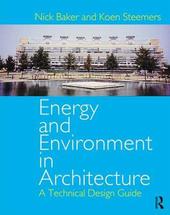
|
Energy and Environment in Architecture: A Technical Design Guide
Paperback / softback
Main Details
| Title |
Energy and Environment in Architecture: A Technical Design Guide
|
| Authors and Contributors |
By (author) Nick Baker
|
|
By (author) Koen Steemers
|
| Physical Properties |
| Format:Paperback / softback | | Pages:236 | | Dimensions(mm): Height 276,Width 219 |
|
| Category/Genre | Architecture
The environment |
|---|
| ISBN/Barcode |
9780419227700
|
| Classifications | Dewey:720.47 |
|---|
| Audience | | Professional & Vocational | |
|---|
| Illustrations |
200 Line drawings, black and white; 50 Illustrations, black and white
|
|
Publishing Details |
| Publisher |
Taylor & Francis Ltd
|
| Imprint |
Spon Press
|
| Publication Date |
23 December 1999 |
| Publication Country |
United Kingdom
|
Description
Half of global energy consumption occurs in buildings. Increasingly, the concern is not only to create a comfortable and healthy environment within each building, but also to ensure sustainability of resources. The environmental performance of buildings in relation to their design is a pressing issue. Energy and Environment in Architecture explains the principles behind the LT Method (2.1), a manual design tool developed in Cambridge. The LT Method is a unique way of estimating the combined energy usage of lighting, heating, cooling and ventilation systems, to enable the designer to make comparisons between options at an early, strategic stage. Other environmental design issues relating to energy use and to the quality of the internal environment, which cannot be calculated by one unified method, are also described. These topics include thermal comfort, noise and natural ventilation. Energy and Environment in Architecture is primarily aimed at designers of non-domestic buildings, and is illustrated by case studies of health, education and office buildings. The emphasis is on the impact of decisions made when developing the design for a new building, but many of the principles can be applied to refurbishment or remodelling. Energy and Environment in Architecture is an essential handbook, providing both a generalized description of the issues and a blueprint for responding to specific design proposals. By providing a systematic approach to the environmental issues facing every architect and engineer at the concept stage of designing a building, this book enables designers to develop their own approach to energy efficient design.
Reviews'With the help of a guide such as this, architects are enabled to exchange ideas and to ask more penetrating questions of fellow consultants.' - Architecture Today
|